
Table of Contents:
– Background
– How the 5-25×56 LR differs from the ZP5 5-25×56
– Look and Feel
– Reticle Options
– Comparative Optical Evaluation
– Mechanical Testing
– Summary and Conclusion
– Your Pro and Con Breakdown:
– Testing Methodology
Background:
One of the things I get routinely asked is why company X or Y that makes higher tier optics doesn’t make a less expensive version of their model Z scope that just features less expensive, lower grade glass. The premise is that the individual is less concerned with optical performance than the features, mechanical performance, and price. I do not generally like this question as it makes what I think are inaccurate assumptions about mechanical performance and the relationship of price to it, discounts the importance of optical performance, and assumes too much simplicity in the nature of optical design. Lower cost scopes do not JUST have lower grade glass. They also typically have fewer elements arranged in a simpler design, a simpler adjustment design with fewer elements, and lower cost lens coatings. Basically, I’m not sure how far simply lowering the grade of glass chosen would actually lower cost but I suspect, very little.
All that being said, the concept is clearly one that customers are interested in, so a market certainly exists: and that is a great deal of the battle in business. Also, most makers of top tier tactical scopes do not have a lower cost product line with similar features. Instead, most have a “hunting” line that costs less but also lacks the basic features preferable for long range shooting, such as a reticle in the first focal plane and having a Mil / Mil arrangement of turrets and reticle. The 5-25×56 LR represents what I see as something of a trial balloon for Minox when it comes to filling this oft inquired about but mostly ignored niche. Being available only in the most popular options for the market segment, 5-25x magnification, 56mm, mil-mil, and tree reticle, the LR also utilizes the ideas of low SKU count and economies of scale to further chip away at the cost.
How the 5-25×56 LR differs from the ZP5 5-25×56
While the concept of the LR is clearly to be a less costly option for those looking at scopes with the feature set of the ZP5 5-25×56, inside it is not simply a ZP5 with lower grade glass. The optical designs for the LR’s eyepiece and erector came not from the ZP5, but from the former ZE series altered to accommodate a reticle in the first focal plane. The adjustments for the LR are the same as those in the ZP5, and its objective assembly and focus are an entirely new design. As for the glass in the LR, it is different from that in the ZP5 but has the same coatings. So, while side-by-side the LR and ZP5 are near identical in appearance, inside there is a good bit of difference in the optical design, though the adjustments are the same. Both scopes are assembled in the same facility in Germany and both bear the “Made in Germany” marking.
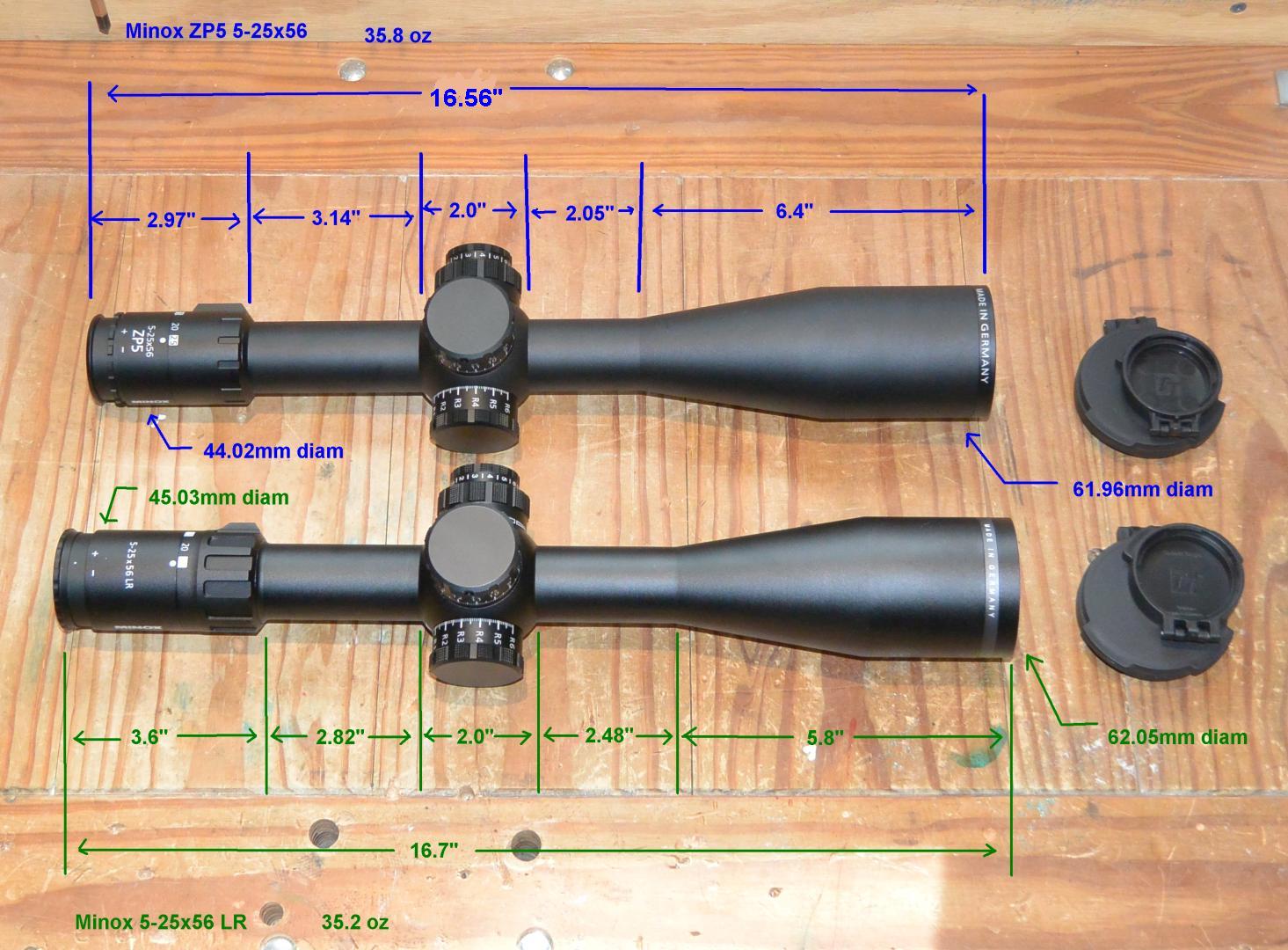
Look and Feel:
The Minox ZP5 5-25×56 and the 5-25×56 LR are remarkably similar in appearance. They have near identical lengths at 16 9/16″ and similar weights at 35.2oz (LR) and 35.8oz (ZP5). These physical sizes and weights are about par for the course when it comes to higher cost scopes in this magnification range. Both Minoxes (Minoxi? Minoxen?) are very similarly styled with an integrated, low profile throw lever on the eyepiece, “Made in Germany” prominently displayed on the objective, and identical adjustment knobs and parallax / illumination knobs. The only substantial difference in appearance is that the ZP5 has a slightly shorter eyepiece which includes a focus lock, whereas the LR’s eyepiece is a bit longer and has no focus lock.
The Minoxes’ adjustments are of the non-lifting type wherein the knob does not raise and lower with adjustment. Like many other designs of this type, Minox includes a turn indicator. In this case, the turn indicator consists of two holes in the ring below the adjustment that shift from showing black to showing white on the second turn. Turrets are marked 0-14 and above that 15-28 for the second turn. Both scopes have a stated elevation of 28mil, so there is no third turn. As is common, the zero stop allows a small amount of adjustment below the zero. The knob size on these Minox scopes is both a little smaller in diameter and shorter than other 15mil knobs I have seen, making for a more compact package. Windage knobs are marked 6 mils in each direction though they will go a little further each way before hitting the stop. Neither elevation nor windage knobs are locking on either model. On both the elevation and windage knobs, the zero stop sets in the most common way: with two set screws you loosen to allow the knob markings and stops to be repositioned to zero once scope has been zeroed. Knurling on the knobs are a little on the sharp side and can dig in a bit if the knobs happen to be on the stiff side. I say happen to be because across two scopes the force required for knob movement is not the same on any of the four knobs in question. The lightest, which is the LR’s elevation knob, is followed by that scope’s windage knob. Still stiffer is the ZP5 elevation, and the ZP5’s windage is stiffest of all. For this Goldilocks, the LR’s windage is the right temperature and I suspect most will either favor that or the ZP5’s elevation. I am baffled as to why there is such tremendous variation on the force required to rotate the different adjustments across these two scopes featuring identical adjustment knobs. The lightest requires only a light two finger grip while the stiffest requires a substantial grip with the knurling on the knob becoming uncomfortable. They are just not close. We’re talking about a range of at least three times the required torque from lowest to highest.
The illumination and parallax controls on the other hand are similar in force across both and in a good feel range. The combined illumination / parallax knob is well designed in that the parallax part is much larger and therefore easy to adjust without also inadvertently turning the illumination on. In the case of both of these scopes, only the center of the reticle is illuminated, and, as with most other long range high power scopes, this illumination is not daytime bright. Both scopes feature 11 brightness settings on the illumination with an off position between each. In each case, they start off far too dim to see with the naked eye. I suspect this is for NV use and they seem to hint at this in the manual without actually saying it. The ZP5 illumination has an illumination auto shutoff after 3 hours of continuous use, but the LR has no such failsafe. The power ring is a little lighter on the LR than the ZP5, but both are in a good range and given the different optical designs, I really wouldn’t expect them to be the same anyway. Neither scope showed a zero shift with parallax or power adjustment.
Finally, the fit and finish on both the ZP5 and the LR is perfect, as you would expect, without any tool marks, unevenness, or blemishes.
Reticle:
Though it is often surprising to those in fields not related to business administration, lowering the SKU count (making less options) for a product is actually a hugely effective way to reduce the price necessary to make a profit on said product. You could call this the model T strategy after Ford’s world changing conveyance available in any color you want as long as it’s black. The Minox 5-25×56 LR is available in any configuration you want as long as it’s a 5-25 power with a 56mm objective and illumination in Mil / Mil with the LR reticle.
The LR reticle has what I would now call the most common set of features in that it has a floating dot center, .2mil graduations, and a Christmas tree. Minox has done a better job than most with these most features in a number of ways. First off, the LR has only 2 mils of crosshair at the 12 o’clock position. This leaves the top half of the reticle mostly open and, I think, helps a good deal with seeing trace. To help with visibility in the Christmas tree section, they have also used small floating dots for the markings instead of a full ladder. The value of a Christmas tree vs. simply leaving the area open for better visibility will always be debated, but making the tree less obtrusive when present seems to generally be seen as a win. Since confusion makes you slow and mistake prone, Minox has opted for all .2 mil graduations in the reticle. It is simple, very simple, and hard to make any measurement mistakes with. Another feature I think is nice is the way the crosshairs, which start quite fine in the center, continuously widen after 5 mils each direction horizontally and 10 mils vertically. This gives the scope some usefulness at minimum power in a pull-up-and-shoot time-sensitive capacity. So utilized, its very fine mil scale mostly disappears, leaving something akin to a German #3 reticle. I would characterize the LR design as a highly optimized implementation of the most popular features in long range reticles today. If I had to choose a reticle design to market in a scope with only one available reticle, this is it.
In my testing, the reticle measured 1% small with 10.1 mils on the reticle being 10.0 mils on a properly calibrated target. The reticle was also canted ~.6 degrees (.2mils in 19mils travel) counter-clockwise relative to the adjustments.
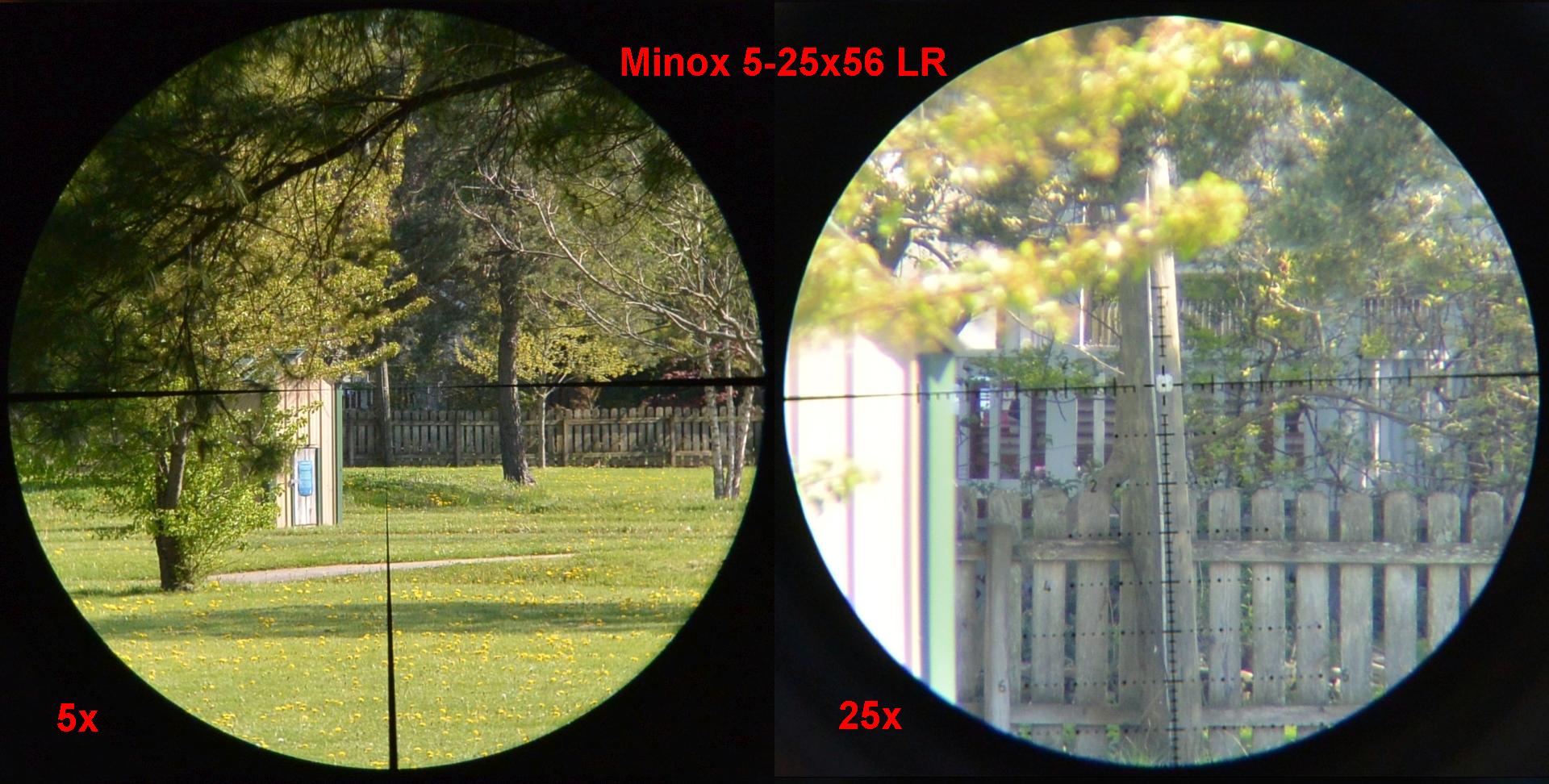
Comparative Optical Evaluation:
For optical comparison with the Minox 5-25×56 LR, I first have two other scopes in this year’s series of ~$2k long range scope reviews: the Sig Sauer Tango 6 5-30×56 and the Leupold Mark 5HD 5-25×56. Of course, I also compared the LR it to its big brother, the Minox ZP5 5-25×56, and this brought in a ZCO420 as a comparison for the ZP5. Lastly, I pulled out an Athlon Midas TAC 5-25x56mm in order to have a particularly good example of a sub $1k scope. For the most part, the LR will be compared to its price peers, but I do like to see how things fit into the full picture so I always tend to pull out a few scopes of both much higher and much lower cost when I get to evaluating optical performance.
As should be expected, but is not always the case, the optical performance of the scopes compared during this review did break down into respective price brackets. All of the ~$2k scopes generally outperformed the ~$1k scope, and the two ~$3k scopes outperformed the ~$2k scopes. That being said, the summary of my impressions is that the Sig Tango6 was optically closer to the $1k scope than the $3k scopes and the Leupold Mark 5HD and Minox LR were closer to the $3k scopes, though quite different from each other in terms of what areas of optical performance they excelled in.
The Minox 5-25×56 LR’s performance high point is probably its field of view and how edge-to-edge good that view is. Its FOV is closer to the ~$3k scopes than to those in its price bracket, and it is quite good edge-to-edge, being a little better than the Leupold despite the larger FOV. I should note, however, that Minox lists the LR on its website as having the same FOV at 25x as the ZP5, though a smaller FOV at low power. This is an error. The ZP5’s is wider at both ends of the power range as should be expected. The LR has a great FOV, but you’re not pulling one over on its big brother. Also a win for the LR was its low light performance. It actually bested all other scopes at any price range when it came to performance as dusk faded. This may have had something to do with its particularly large and comfortable eyebox.
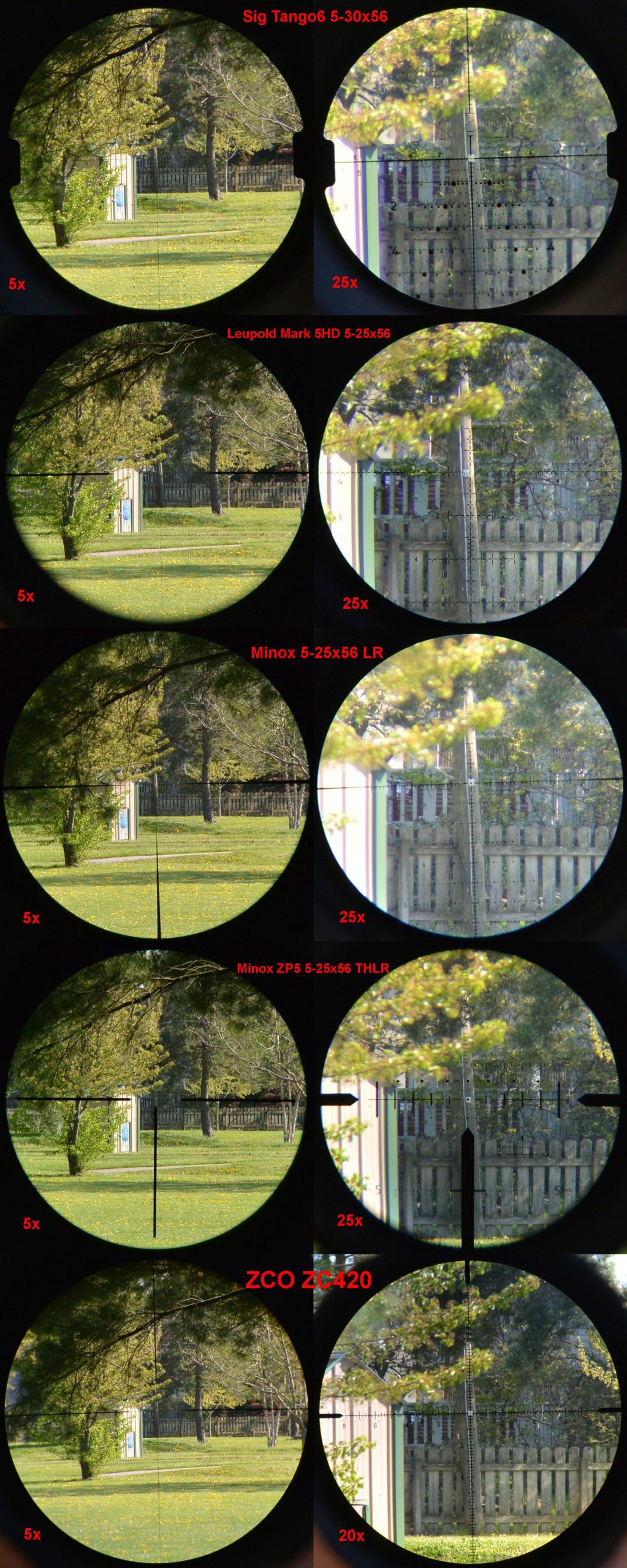
Resolution is very often the big factor between scopes when it comes to the user’s overall impression of which is better than which. That simply was not the case in this lineup. Though the LR finished in the middle, all three of the ~$2k scopes impressed with their resolution performance. I went back and forth a bit regarding which was better than which and actually tested resolution in three separate sessions. I also went back and forth some on the rankings regarding pincushion / barrel distortion, but did not worry myself too much as it matters little on high powered scopes the whole lineup did fine. In the end, I didn’t bother ranking them on that metric.
Chromatic Aberration can be a huge factor in scope performance. Excessive and even moderate CA can easily overshadow most other performance dimensions. Happily, the Minox 5-25×56 LR performed objectively well. It also performed very similarly to its big brother and the Leupold Mark 5HD. The LR also performed better than its price peers in contrast, though a little behind in color fidelity, favoring green a bit much.
The first area where I felt the LR performed poorly for its price point was in stray light handling. The LR was easier to wash out in disadvantageous angles than I would like and generally just had a bit more white haze than average. The degree of this issue is not large, but it is noticeable. A more important issue for the Minox 5-25×56 LR is its shallow field of view. You are probably not going to see any trace with this scope ever, do if you shoot in competitions or other situations where you are forced for time or stage rules to shoot at targets that you have not focused the parallax to, you are going to have issues.
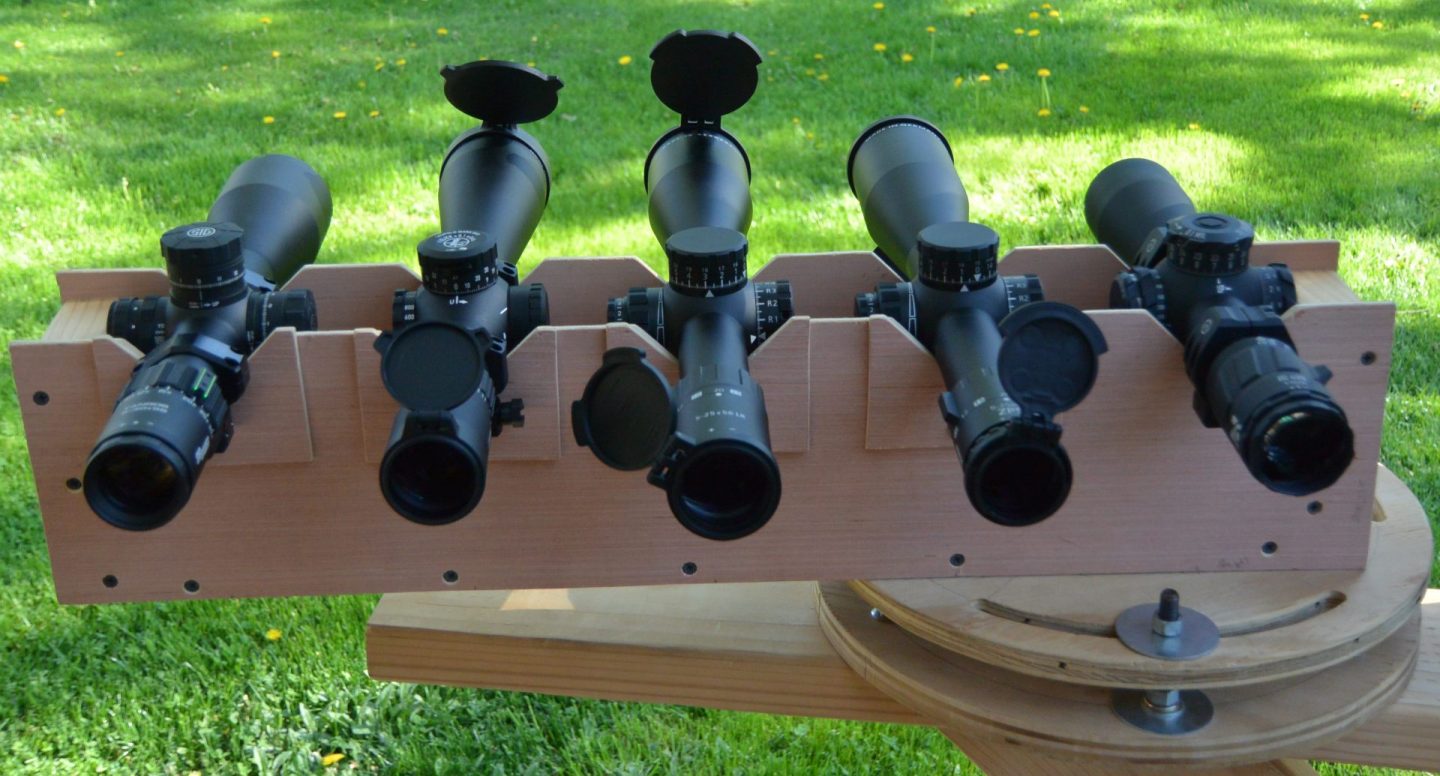
Mechanical Testing:
The mechanical performance of the Minox 5-25×56 LR I tested is complicated because there were three independent factors that could lead the amount a user reads on their adjustments being different from how much the adjustments actually moved the reticle. All three of these factors are relatively small in magnitude but they can interact with each other, sometimes amplifying error and sometimes correcting it.
The first factor complicating the mechanical adjustment is what I will call ‘spline slop’. All scopes that have either a non-rising elevation knob, as this one does, or a pull up to unlock / down to lock knob have a spline connecting the knob to the actual threaded adjustment plunger. Because the spline has to have clearance to slide, there is always some slop in such scopes. Often, the magnitude of this necessary slop is far too small to measure but sometimes, it is quite noticeable. The slop manifests itself as the scope’s internals being in a different position at the same number on the knob when the scope is adjusted up to that number rather than if it were adjusted down to that number. For instance, you might adjust up to 5.0 mils from zero and have moved the reticle 5.0 mils on target. Then you shoot further out, say to 10 mils, after which you go back to the target that was at 5.0 mils, but this time you are coming down from 10 mils. If you have .1mil of slop in the system, you will now find yourself at 5.1mils on the target and not 5.0 as before, even though the knob will read the same 5.0mils as before. This can be an issue since people usually adjust down to zero but then move up from zero to most of their shooting solutions. Because of the change in direction, the slop error will be added to any such solutions as a matter of routine. The error can be eliminated by a shooter that becomes habituated to it and is quite careful to always adjust to the solution from same direction regardless of situation. For instance, if the shooter always goes up to the solution, he will turn down past zero each time before going up to it and when he wants to fine tune down .1 mil, he will go down .2 mils and back up. In the case of the Minox 5-25×56 LR, the spline slop magnitude measures at .1mil. This was also the case on the Minox ZP5, so I think it’s likely that all Minox scopes with this turret design have this same (or quite similar) .1mil spline slop.
The second factor complicating the mechanical adjustment of the Minox 5-25×56 LR was the adjustment magnitude error. Most scopes have some deviation from perfect adjustment magnitude, though they are doing far better now than just a few years ago. Often, we measure this adjustment magnitude error as a percentage such that a scope reticle that moves 10.1 mils when adjusted 10.0 mils tracks at 101% and a reticle that moves 9.9 mils when 10.0 is dialed tracks at 99%. Frank has helpfully compiled a list of adjustment deviation of all scopes he has tested in class that can give you an idea of how often, and by how much, adjustment magnitude deviates from ideal. For his list, he standardizes at up 10.0 mils from the shooter’s zero (this varies from scope optical zero due to barrels and canted scope bases). My measurements are from optical zero – or as close to it as I can get if I the scope is mounted in a funky base that is hard to get perfectly centered in the v-block. In the case of this scope, I was certainly off ~2 mils or so from perfectly centered judging by how much adjustment the scope had above zero and below. Deviations are not always linear in nature and can sometimes correct themselves if you cross the optical zero halfway through so ‘as close to zero as possible’ gives the tester the best understanding of what is happening in the instrument. At 100 clicks, 10.0 mils up from zero, the Minox 5-25×56 LR moved 9.8 mils on target for a 98% score on the Frankometer. Its full travel up from zero was 191 clicks or 19.1mils, at which point it had moved 18.8 mils on target for the same 98% rating. Interestingly, going down from zero, its deviation never exceeded .05%. It traveled 12.5mils down and read 12.5 on the target at that point, for a 100% rating. Total travel was therefore 31.6mils, which is more than the advertised 28.0, though I suspect that you could not get a full 31.6 up from zero in practice due to limitations with the two-turn knob. Running the adjustments out to the max lateral movement of 6 mils did not change elevation tracking on this scope.
The last factor in the complicated mechanical behavior of this scope is the turret marking / click alignment. I have read people’s forum posts before complaining of the markings not lining up with the click detents on Minox scopes and Minox told me they have made improvements to remedy this issue. On the ZP5, alignment was indeed always correct, but on the LR it was more complicated. A full revolution on the LR’s turret is 150 clicks and is marked 15.0 mils. You will be at both those numbers at a full revolution. However, if you rotate up from zero 100 clicks, the turret will not actually read 10.0 mils, rather you will be aligned with 9.9 mils on the turret. So, the markings are a little wider spaced than the clicks for about the first half of the turret and a little narrower the second half, bringing things back to alignment at the full turn.
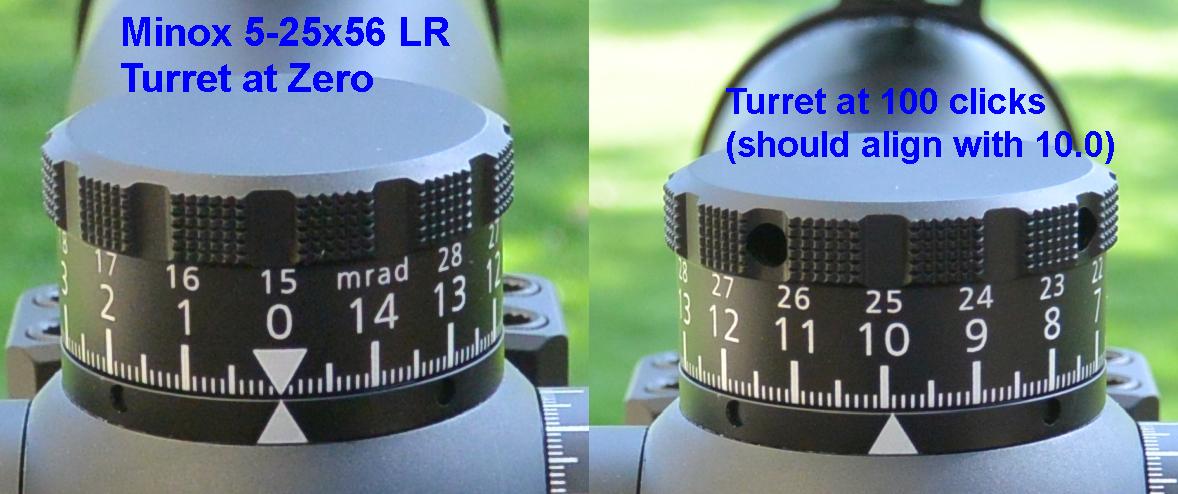
Taken all together, the three complications to the Minox adjustments can stack in some interesting ways. For example, when I started testing, I had a zero I had adjusted down to and from which I adjusted up from. Thus, my first click was all spline slop and did not move the adjustment at all, and therefore all my subsequent adjustments were .1 mil too small because of that slop. When I adjusted 100 clicks, I was at 9.7 mils on target due to the 98% tracking plus the .1mil spline slop, but only at the 9.9mil hash on my adjustment knob due to the turret marking / click alignment error. So, the knob marking alignment error actually helped me since it was in the same direction as the adjustment magnitude deviation. As I said, it’s complicated. The takeaway is that my test scope was never more than 2 clicks off from the value you read on the adjustments, though how you get to knowing exactly how far off it is can be complicated and confusing. In practice, this can be difficult to deal with as some of the smallest targets I shoot in competition subtend only .2mils. The errors in turret alignment and adjustment magnitude can be dealt with when you true your firing solution to your actual real world data. They will just make you look like you have a little different BC than you actually do. The spline slop is a little harder. In practice, you can totally eliminate it by always adjusting the same way to your number, but this takes practice and until then you are quite likely to go .1 mil down to make a correction instead of .2 down and back up .1mil. I will finish by saying that the return to zero on this scope was correct, provided you came to it from the same direction and that there was no point of aim shift with power or parallax adjustment.
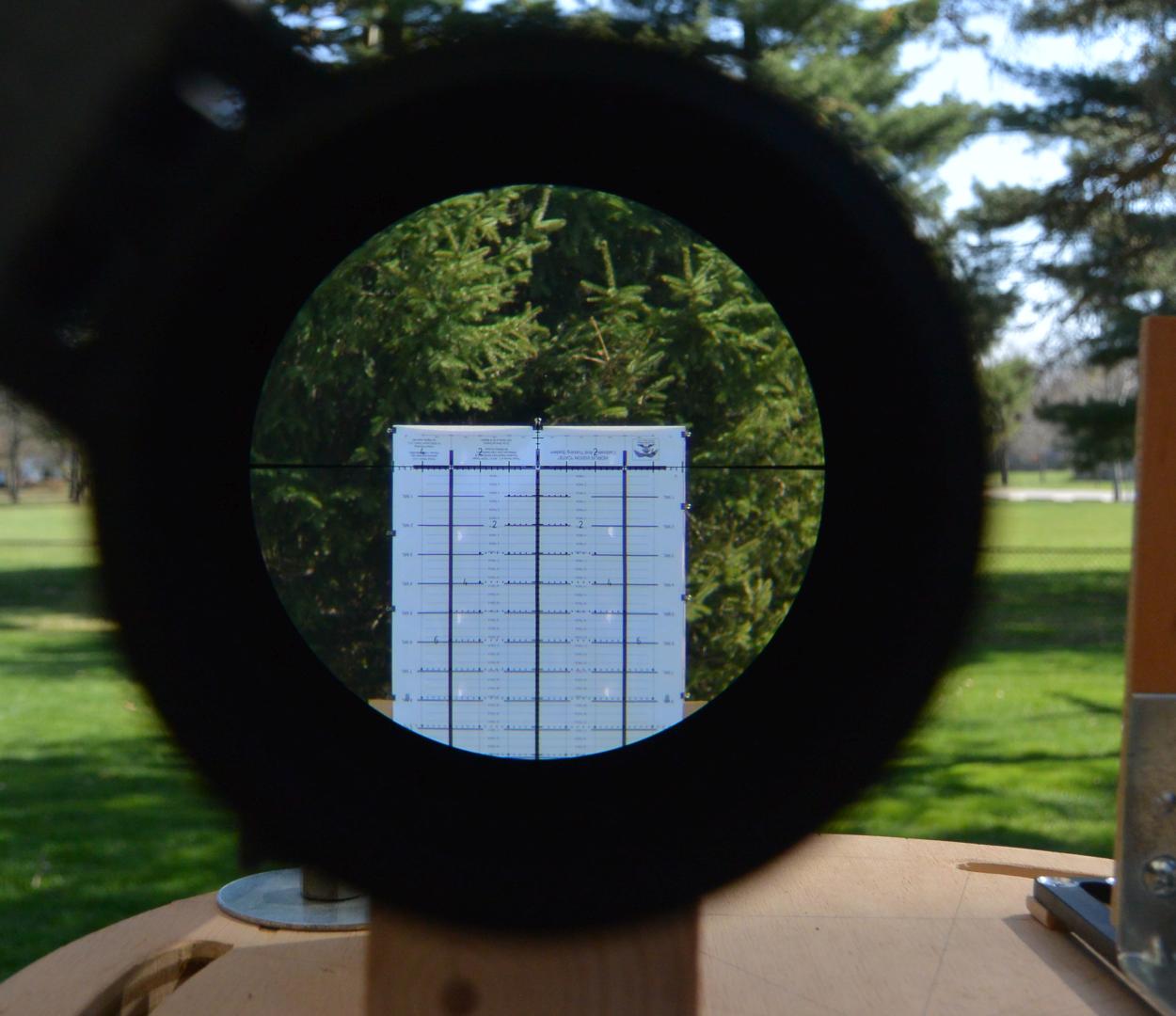
Summary and Conclusion:
On balance, I found the Minox 5-25×56 an excellent performer optically. Across most dimensions of optical performance it was better than average at its price point, with field of view size, edge-to-edge clarity, and low light performance being its highest points. This comes with the caveat that its depth of field was worst in class and noticeably poor. As such, it will have difficultly spotting trace nor will it excel in situations where the shooter cannot, or does not have time to, focus the scope for each target. The LR’s reticle design generally enhanced its optical advantage by giving you an almost totally unobstructed open upper half with which to best observe your target and perhaps partially compensate for the poor depth of field when observing trace. A less busy Christmas tree than most will also give you a better chance of more accurately making out shot impacts falling within that area. I was not really expecting to be talking about a reticle in this review, but despite it having a Christmas tree and my recent movement away from that feature, I like this reticle. I think it is the most polished embodiment of the .2mil hash, floating dot center, mil Christmas tree model that has become close to standard in the industry.
On the flip side of the coin for the 5-25×56 LR were the mechanical aspects that just weren’t perfect, such as the .6 degree reticle cant, 1% reticle size deviation, and 2% adjustment magnitude deviation. Such degrees of deviation from ideal are common individually, but few scopes show so many small deviations in one optic. The parallax also did not focus to the 50 meters specified, but only made it to around 75 and, given the shallow depth of field, was too far out of focus at 50 to be usable. This rules out effective use of the scope in the long range .22lr competitions that are becoming common. In addition to having the above common deviations, the LR also had a few unusual foibles: an unusually large amount of spine slop, a significant degree of turret marking / click alignment deviation, and large variance in adjustment stiffness. Given all these factors, I was not left with the best impression of the quality control.
There is a good deal of competition in the ~$2k price range where the Minox 5-25×56 LR sits. A number of brands offer scopes OEM’d from Light Optics’ Japanese facility in this range, and both Burris and Leupold produce U.S. made models as well. The Minox 5-25×56 LR gives you a Western European entry at that price. It has a feature set and extras more common in alpha level products, such as a 15mil per turn non-rising elevation knob with turn indicator and Tennebrex flip caps. Between the features and the optical performance, it is perhaps the most Alpha-tier-like scope at this price point. Hopefully the number of QC related issues in my test scope is indicative of the first shipment of this product and practice will make more perfect.
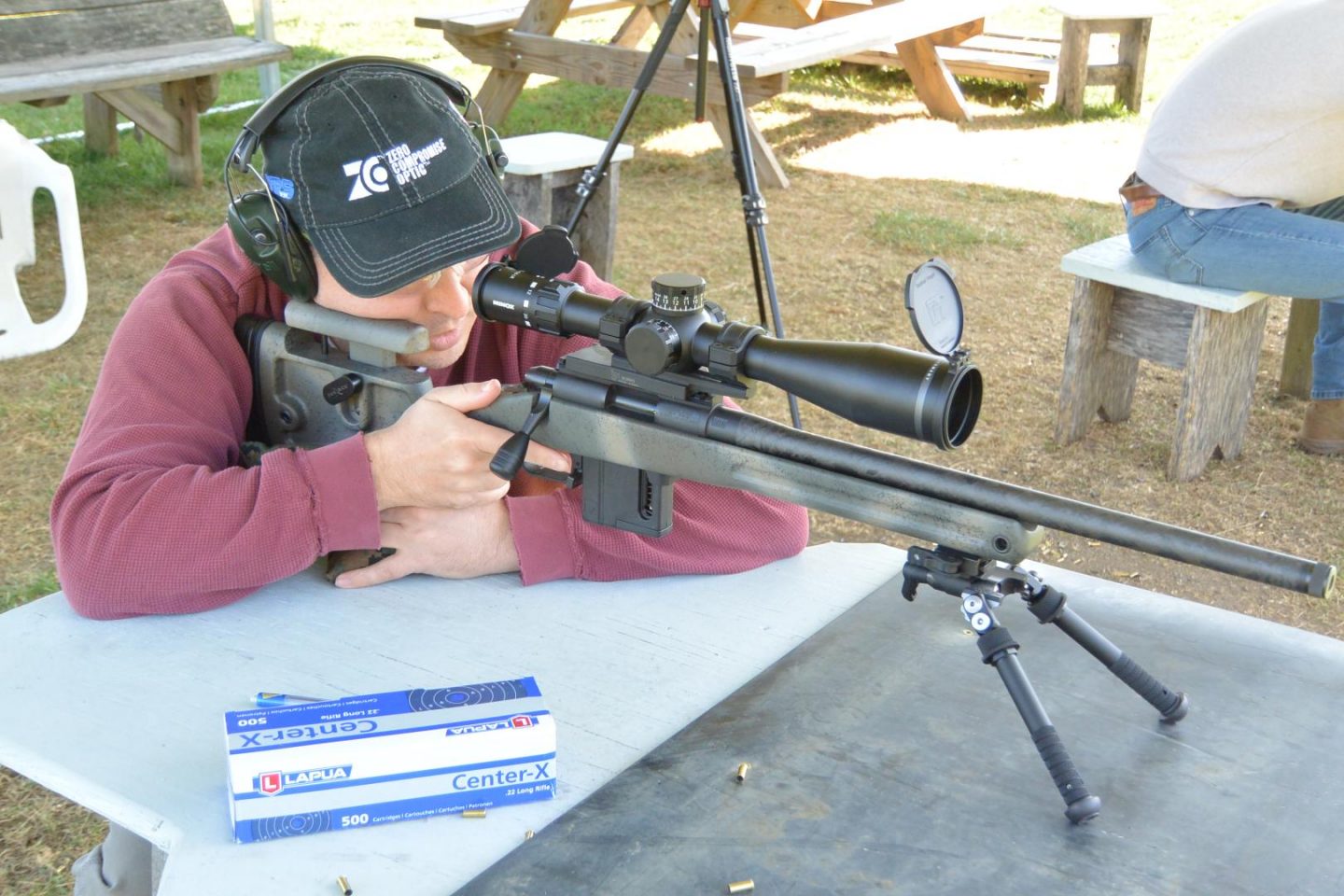
Your Pro and Con Breakdown:
Pros:
– Feature rich 15mil / turn non-rising elevation knob with turn indicator
– Reticle is illuminated
– Excellent LR reticle
– Excellent optical performance particularly with respect to FOV and edge to edge clarity.
– Tennebrex flip caps included
– Made in Germany
Cons:
– large .1mil spline slop in adjustments and large variance in adjustment stiffness from example to example
– My example was 1% off on both reticle and adjustment magnitude, had .6% reticle cant, and had significant turret / click misalignment.
– Scope has poor depth of field and did not focus closer than 75 meters.
– 10 year warranty is less than the industry norm

